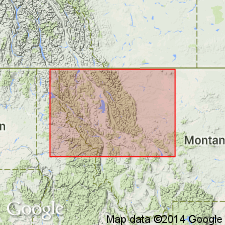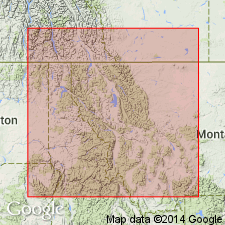
- Usage in publication:
-
- Roosville member
- Modifications:
-
- Revised
Summary:
Revised as the middle member of the Miller Peak formation of the Missoula group of the Belt series. Type locality said to be 3 mi east-northeast of the Phillips Creek Cascade, near Roosville, BC, Canada. Overlies Kintla member of Miller Peak. Underlies Mt. Rowe member of Miller Peak. Ranges form 550 to 1,000 ft thick. Composed of green, green-gray, and olive, thin-bedded, fissile argillite and argillaceous sandstone. Mud cracks, ripple marks, and salt casts common. Of pre-Cambrian age.
Source: GNU records (USGS DDS-6; Denver GNULEX).

- Usage in publication:
-
- Roosville Formation
- Modifications:
-
- Overview
Summary:
Is used in the International border area, CN. Stratigraphic position and correlation with Precambrian formations of the Belt Supergroup of the U.S. in the Northern Rocky Mountain region, and with the Purcell Supergroup of Alberta and British Columbia, Canada shown on figures 4 and 6.
Source: GNU records (USGS DDS-6; Denver GNULEX).
For more information, please contact Nancy Stamm, Geologic Names Committee Secretary.
Asterisk (*) indicates published by U.S. Geological Survey authors.
"No current usage" (†) implies that a name has been abandoned or has fallen into disuse. Former usage and, if known, replacement name given in parentheses ( ).
Slash (/) indicates name conflicts with nomenclatural guidelines (CSN, 1933; ACSN, 1961, 1970; NACSN, 1983, 2005, 2021). May be explained within brackets ([ ]).

